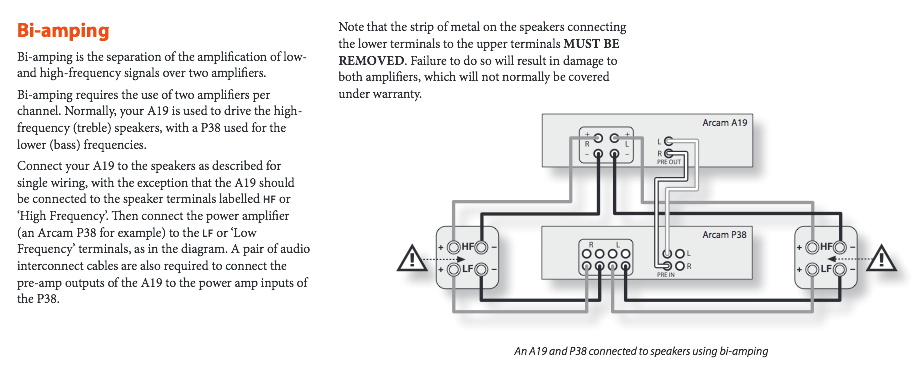- Dec 25, 2013
- 6
- 0
- 0
So for a while I've been thinking that my next upgrade will be a preamp+DAC. I'm happy with the sound of my current setup, but the A19 has a bunch of analogue inputs of which I only use one, to my DAC. And I use three of the DAC inputs to different sources. Somehow, it'd make more sense to manage volume and input selection on the same device.
Preparing for this, the first I needed is a power amp as the A19 does not have a direct or AV power input. And I've been able to get a hold on a second-hand P38 at a decent price, so I've gone ahead and bought it. It will still be a few days until I get it, though.
I've been checking how to connect the A19 and the P38 and I have two options: either using only the P38 for power amplifying, or in a bi-amp setup. I think I will play with both as the A19 and P38 produce distinctly different sounds and I am curious as to how a preamp and a power amp sections affect the different qualities of the sound—such as maybe airness remains similar with both power amps, but tightness will differ, and stuff like that. This promises to be interesting and should keep me occupied for a while.
Now, I've never tried bi-amping before, so I don't have any experience with it. But checking the setup recommended by Arcam in the A19 user guide, a question has popped in my mind and I hoped someone with more experience could help me with it. The setup is the following:

And my question goes like this: if the preamp section of the A19 controls the volume of both its power amp section, and of the P38, and these are connected to the LF and HF posts of the speakers, respectively, shouldn't the volume of the LF be higher than that of the HF taking into account that the P38 has double the power than the power section of the A19? The obvious answer for this should be no… Otherwise, it wouldn't make sense that Arcam would recommend this setup. But then, I don't know why.
It could also be that the preamp output of the A19 is volume-matched to the P38. But then, does that mean that it wouldn't work well with another amplifier that has different power? And this would also imply that the A19 wouldn't be able to achieve the maximum output from the P38, as the upper limit would be set by its own internal power amp section.
I'm sure this is much easier than I see it at the moment. Hope that someone with more experience in bi-amping setups can shed some light over this. Thanks!
Preparing for this, the first I needed is a power amp as the A19 does not have a direct or AV power input. And I've been able to get a hold on a second-hand P38 at a decent price, so I've gone ahead and bought it. It will still be a few days until I get it, though.
I've been checking how to connect the A19 and the P38 and I have two options: either using only the P38 for power amplifying, or in a bi-amp setup. I think I will play with both as the A19 and P38 produce distinctly different sounds and I am curious as to how a preamp and a power amp sections affect the different qualities of the sound—such as maybe airness remains similar with both power amps, but tightness will differ, and stuff like that. This promises to be interesting and should keep me occupied for a while.
Now, I've never tried bi-amping before, so I don't have any experience with it. But checking the setup recommended by Arcam in the A19 user guide, a question has popped in my mind and I hoped someone with more experience could help me with it. The setup is the following:

And my question goes like this: if the preamp section of the A19 controls the volume of both its power amp section, and of the P38, and these are connected to the LF and HF posts of the speakers, respectively, shouldn't the volume of the LF be higher than that of the HF taking into account that the P38 has double the power than the power section of the A19? The obvious answer for this should be no… Otherwise, it wouldn't make sense that Arcam would recommend this setup. But then, I don't know why.
It could also be that the preamp output of the A19 is volume-matched to the P38. But then, does that mean that it wouldn't work well with another amplifier that has different power? And this would also imply that the A19 wouldn't be able to achieve the maximum output from the P38, as the upper limit would be set by its own internal power amp section.
I'm sure this is much easier than I see it at the moment. Hope that someone with more experience in bi-amping setups can shed some light over this. Thanks!

